Study on the Comprehensive Health Effects of Coastal Green Areas in Qingdao City, China
Abstract
:1. Introduction
2. Materials and Methods
2.1. Study Area
2.2. Plot Settings
2.2.1. Coastal Line Location Division and Coastal Distance Determination
2.2.2. Classification and Selection of Coastal Green Spaces
2.3. Methods
2.3.1. Data Collection
2.3.2. Data Analysis
3. Results
3.1. Negative Air Ion Concentration
3.2. Airborne Particulate Matter
3.3. Forest Microclimate and Human Comfort Index
3.4. Acoustic Environments Index
3.5. Coastal Green Comprehensive Health Index Evaluation
4. Discussion
4.1. Differences in the Health Effects of a Single Recuperative Factor between Different Landscape Compositions
4.2. Differences in Health Effects of a Single Recuperative Factor between Different Landscape Configurations
4.3. Differences in Health Effects of Single Recuperation Factors between Different Coastal Distances
4.4. Rehabilitative Landscape Design and Integrated Health Effects of Coastal Green Space
5. Conclusions and Recommendations for Urban Greening and Planning
Author Contributions
Funding
Data Availability Statement
Conflicts of Interest
Appendix A. Schematic Diagram of the Test Site
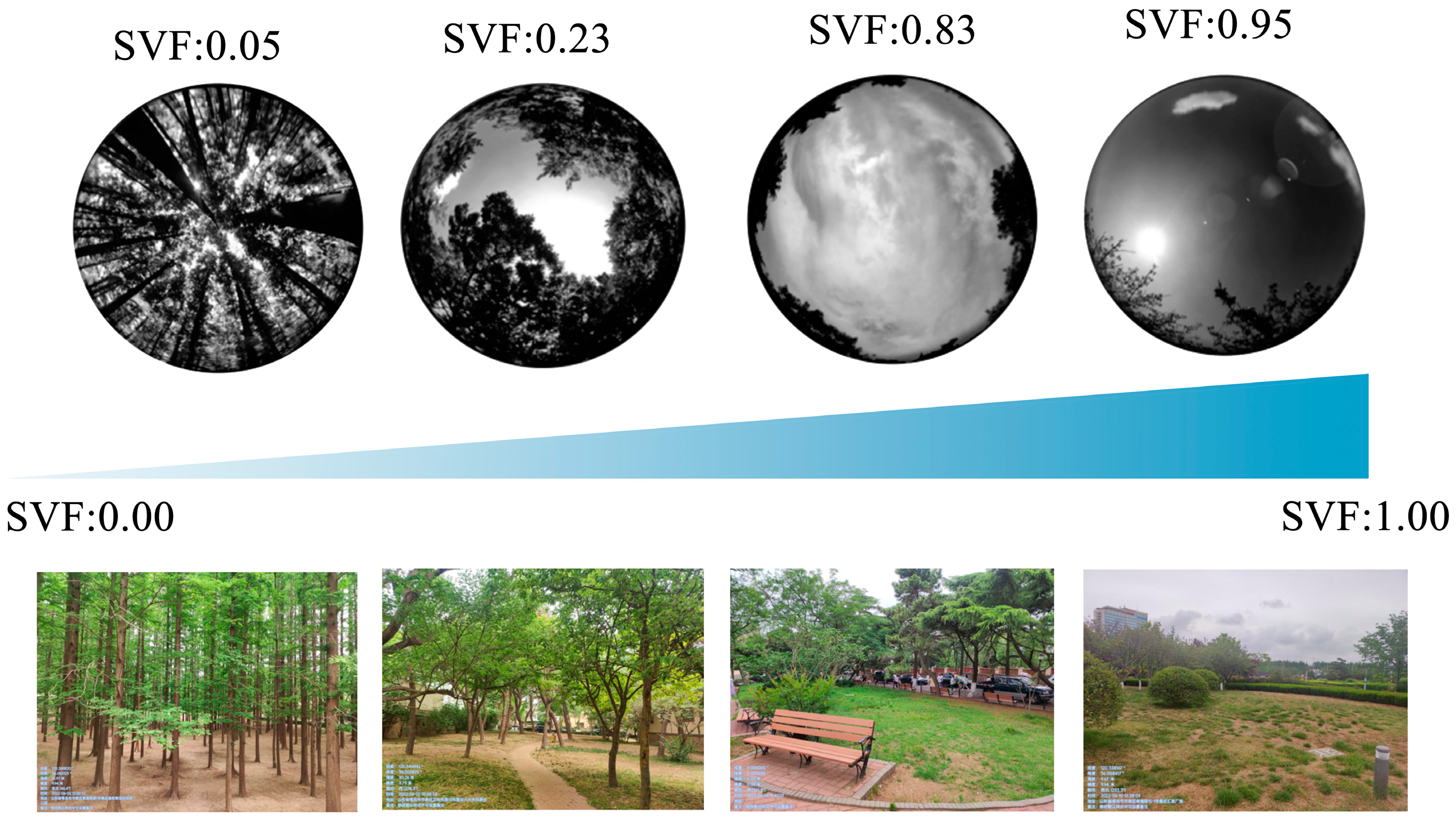
Appendix B. Criteria Sheet for Evaluation of Conditioning Factors
| Grade | Air Cleanliness Evaluation Table | Air Particle Concentration Evaluation Table | Comfort Index Evaluation of Lu Ding Huang | Acoustic Environments Index Evaluation Criteria | ||||||
|---|---|---|---|---|---|---|---|---|---|---|
| CI | Cleanliness of Air | PM10 (μg/m3) | Health Effects | PM2.5 (μg/m3) | Health Effects | S | Health Effects | NF (dB) | Health Effects | |
| I | >1.0 | Cleanest, excellent health effects | ≤50 | Clean | ≤35 | Clean | S ≤ 4.55 | Very comfortable | <40 | Very quiet |
| II | 1.0–0.7 | Cleaner, stronger health effects | 50–150 | Medium | 35–75 | Medium | 4.55 < S ≤ 5.75 | Comfortable | 40–50 | Quiet |
| III | 0.69–0.50 | Moderately clean, average health effect | >150 | Contaminated | >75 | Contaminated | 5.75 < S ≤ 6.95 | Medium | 50–70 | Quieter |
| IV | 0.49–0.30 | Permissible range, weaker health effects | – | – | – | – | 6.95 < S ≤ 9 | Uncomfortable | 70–90 | Noisier |
| V | <0.29 | Below the threshold, no health effects | – | – | – | – | S > 9 | Extremely uncomfortable | 90–120 | Noisy |
| VII | – | – | – | – | – | – | – | – | >120 | Not conducive to physical and mental health |
Appendix C. Coastal Green Comprehensive Health Index Evaluation
| Test Site | NAIC | PM10 | PM2.5 | S | NF | CGHI | Grade |
|---|---|---|---|---|---|---|---|
| 5 | 0.904 | 0.760 | 0.934 | 0.433 | 0.691 | 0.803 | I |
| 19 | 0.839 | 0.883 | 0.932 | 0.488 | 0.621 | 0.799 | I |
| 20 | 0.604 | 0.930 | 0.835 | 0.581 | 0.885 | 0.793 | I |
| 27 | 0.702 | 0.787 | 0.787 | 0.671 | 0.881 | 0.773 | I |
| 2 | 0.547 | 0.935 | 0.955 | 0.395 | 0.752 | 0.770 | I |
| 18 | 0.730 | 0.807 | 0.654 | 0.440 | 0.898 | 0.761 | I |
| 28 | 0.743 | 0.815 | 0.804 | 0.452 | 0.749 | 0.761 | I |
| 24 | 0.656 | 0.904 | 0.898 | 0.787 | 0.669 | 0.760 | I |
| 34 | 0.676 | 0.805 | 0.784 | 0.450 | 0.783 | 0.745 | I |
| 16 | 0.726 | 0.884 | 0.808 | 0.586 | 0.631 | 0.745 | I |
| 36 | 0.670 | 0.762 | 0.944 | 0.510 | 0.670 | 0.738 | II |
| 15 | 0.687 | 0.744 | 0.697 | 0.614 | 0.875 | 0.737 | II |
| 23 | 0.721 | 0.809 | 0.836 | 0.445 | 0.601 | 0.723 | II |
| 25 | 0.822 | 0.726 | 0.688 | 0.414 | 0.644 | 0.709 | II |
| 32 | 0.524 | 0.871 | 0.815 | 0.539 | 0.708 | 0.708 | II |
| 14 | 0.661 | 0.684 | 0.934 | 0.586 | 0.642 | 0.707 | II |
| 29 | 0.655 | 0.774 | 0.854 | 0.467 | 0.589 | 0.698 | II |
| 31 | 0.529 | 0.709 | 0.930 | 0.449 | 0.694 | 0.689 | II |
| 12 | 0.803 | 0.610 | 0.763 | 0.458 | 0.590 | 0.677 | II |
| 30 | 0.712 | 0.707 | 0.702 | 0.662 | 0.639 | 0.677 | II |
| 26 | 0.548 | 0.678 | 0.641 | 0.348 | 0.881 | 0.673 | II |
| 17 | 0.548 | 0.764 | 0.770 | 0.606 | 0.559 | 0.641 | II |
| 1 | 0.617 | 0.613 | 0.597 | 0.823 | 0.779 | 0.641 | II |
| 22 | 0.683 | 0.545 | 0.587 | 0.658 | 0.769 | 0.637 | II |
| 33 | 0.613 | 0.564 | 0.788 | 0.707 | 0.615 | 0.627 | III |
| 35 | 0.746 | 0.393 | 0.246 | 0.537 | 0.850 | 0.564 | III |
| 11 | 0.316 | 0.539 | 0.687 | 0.429 | 0.565 | 0.506 | III |
| 21 | 0.248 | 0.567 | 0.653 | 0.432 | 0.470 | 0.463 | III |
| 9 | 0.260 | 0.451 | 0.485 | 0.321 | 0.676 | 0.454 | III |
| 7 | 0.217 | 0.332 | 0.496 | 0.554 | 0.472 | 0.364 | IV |
| 8 | 0.197 | 0.401 | 0.297 | 0.371 | 0.539 | 0.351 | IV |
| 10 | 0.031 | 0.228 | 0.399 | 0.197 | 0.787 | 0.346 | IV |
| 3 | 0.339 | 0.229 | 0.273 | 0.341 | 0.520 | 0.336 | IV |
| 6 | 0.052 | 0.211 | 0.329 | 0.215 | 0.763 | 0.327 | IV |
| 13 | 0.232 | 0.240 | 0.402 | 0.230 | 0.303 | 0.283 | IV |
| 4 | 0.093 | 0.036 | 0.047 | 0.365 | 0.251 | 0.107 | V |
| Type | Category | NAIC | PM10 | PM2.5 | S | NF | CGHI | Grade |
|---|---|---|---|---|---|---|---|---|
| Landscape compositions | Lawn | 0.351 | 0.505 | 0.575 | 0.446 | 0.558 | 0.486 | III |
| Control groups | 0.101 | 0.178 | 0.295 | 0.253 | 0.526 | 0.268 | V | |
| Coniferous forest | 0.669 | 0.786 | 0.814 | 0.578 | 0.668 | 0.721 | II | |
| Broadleaf forest | 0.677 | 0.727 | 0.793 | 0.541 | 0.699 | 0.711 | II | |
| coniferous Broadleaf mixed forest | 0.712 | 0.728 | 0.701 | 0.506 | 0.812 | 0.730 | II | |
| Landscape configurations | Open space | 0.193 | 0.283 | 0.390 | 0.333 | 0.542 | 0.344 | IV |
| Partially open space | 0.418 | 0.623 | 0.665 | 0.480 | 0.558 | 0.553 | III | |
| Closed space | 0.705 | 0.744 | 0.769 | 0.514 | 0.718 | 0.722 | II | |
| Partially closed space | 0.667 | 0.750 | 0.770 | 0.569 | 0.734 | 0.718 | II | |
| Coastal distance | 0–150 m | 0.578 | 0.642 | 0.637 | 0.512 | 0.661 | 0.6207 | III |
| 150–300 m | 0.539 | 0.656 | 0.695 | 0.508 | 0.654 | 0.6241 | III | |
| 300–450 m | 0.539 | 0.613 | 0.686 | 0.447 | 0.637 | 0.6066 | III | |
| 450–600 m | 0.530 | 0.609 | 0.677 | 0.486 | 0.714 | 0.6209 | III |
Appendix D. Wind Speed and Rose Wind Direction Chart
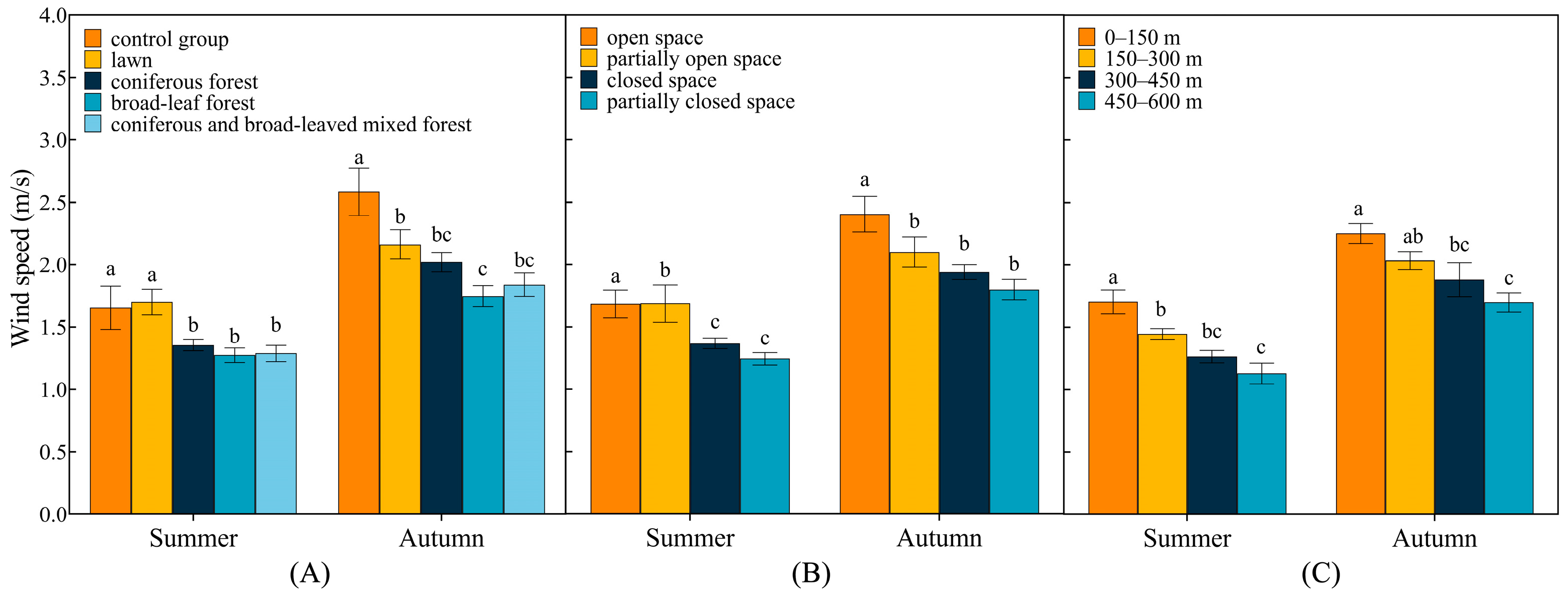
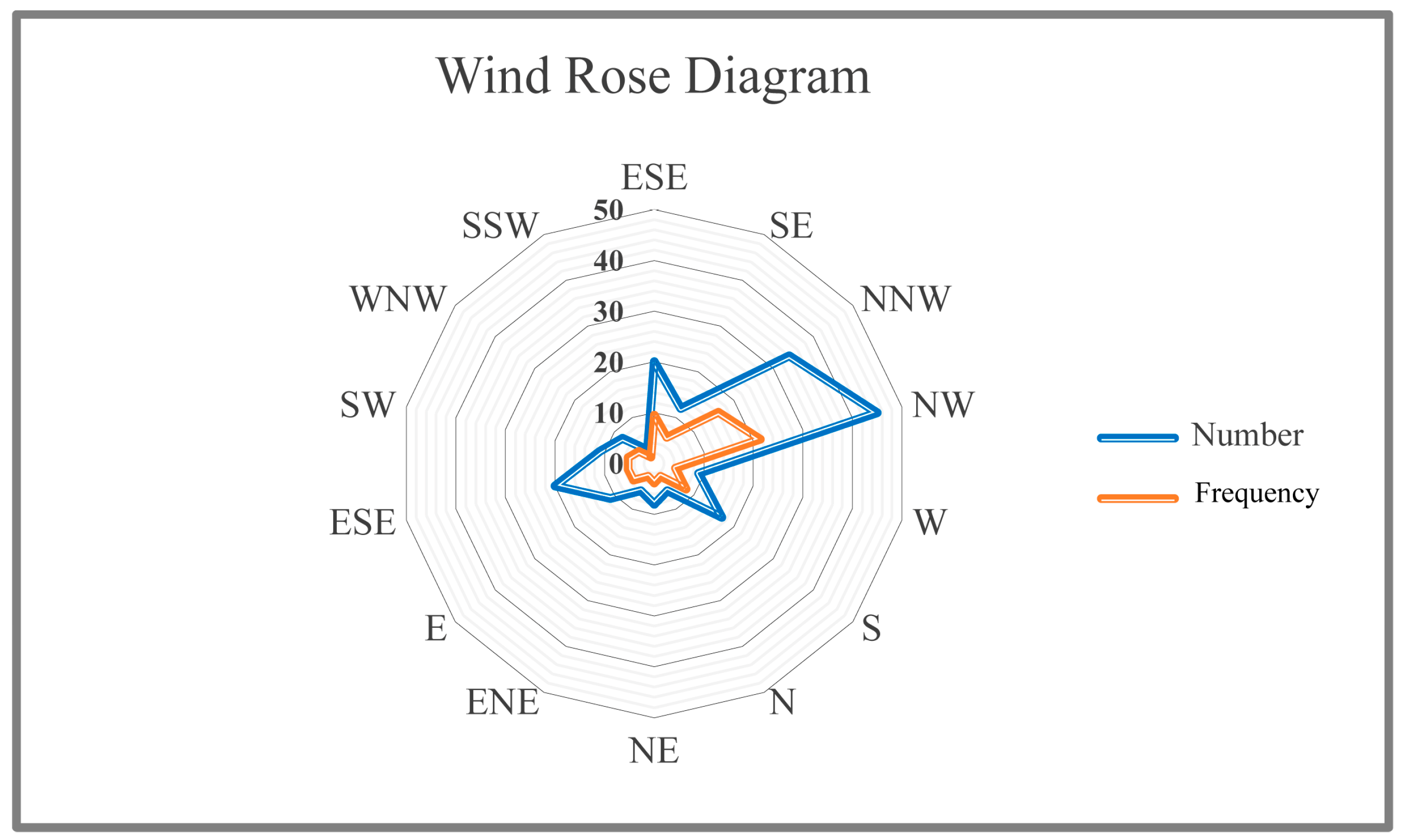
References
- Gruebner, O.; Rapp, M.A.; Adli, M.; Kluge, U.; Galea, S.; Heinz, A. Cities and Mental Health. Dtsch. Aerzteblatt Int. 2017, 114, 121–127. [Google Scholar] [CrossRef] [PubMed]
- He, X.; Zang, T.; Sun, B.; Ikebe, K. Tourists’ Motives for Visiting Historic Conservation Areas in the Post-Pandemic Era: A Case Study of Kuanzhai Alley in Chengdu, China. Sustainability 2023, 15, 3130. [Google Scholar] [CrossRef]
- Huang, B.; Feng, Z.; Pan, Z.; Liu, Y. Amount of and proximity to blue spaces and general health among older Chinese adults in private and public housing: A national population study. Health Place 2022, 74, 102774. [Google Scholar] [CrossRef] [PubMed]
- Sandifer, P.A.; Braud, A.S.; Knapp, L.C.; Taylor, J. Is Living in a U.S. Coastal City Good for One’s Health? Int. J. Environ. Res. Public. Health 2021, 18, 8399. [Google Scholar] [CrossRef]
- Britton, E.; Kindermann, G.; Domegan, C.; Carlin, C. Blue care: A systematic review of blue space interventions for health and wellbeing. Health Promot. Int. 2020, 35, 50–69. [Google Scholar] [CrossRef] [PubMed]
- White, M.P.; Elliott, L.R.; Gascon, M.; Roberts, B.; Fleming, L.E. Blue space, health and well-being: A narrative overview and synthesis of potential benefits. Environ. Res. 2020, 191, 110169. [Google Scholar] [CrossRef] [PubMed]
- Gao, H.; Ning, Y.; Liu, S. The effects of landscape composition and configuration on forest Gross Primary Production (GPP) are affected by climate conditions: Patterns and management implications. Landsc. Ecol. 2023, 38, 2277–2291. [Google Scholar] [CrossRef]
- Chen, Y.; Yuan, Y. The neighborhood effect of exposure to blue space on elderly individuals’ mental health: A case study in Guangzhou, China. Health Place 2020, 63, 102348. [Google Scholar] [CrossRef]
- Huang, R.; Li, A.; Li, Z.; Chen, Z.; Zhou, B.; Wang, G. Adjunctive Therapeutic Effects of Forest Bathing Trips on Geriatric Hypertension: Results from an On-Site Experiment in the Cinnamomum camphora Forest Environment in Four Seasons. Forests 2023, 14, 75. [Google Scholar] [CrossRef]
- Sandifer, P.A. Linking coastal environmental and health observations for human wellbeing. Front. Public Health 2023, 11, 1202118. [Google Scholar] [CrossRef]
- Elliott, L.R.; White, M.P.; Grellier, J.; Garrett, J.K.; Cirach, M.; Wheeler, B.W.; Bratman, G.N.; van den Bosch, M.A.; Ojala, A.; Roiko, A.; et al. Research Note: Residential distance and recreational visits to coastal and inland blue spaces in eighteen countries. Landsc. Urban Plan. 2020, 198, 103800. [Google Scholar] [CrossRef]
- Buonincontri, M.P.; Bosso, L.; Smeraldo, S.; Chiusano, M.L.; Pasta, S.; Di Pasquale, G. Shedding light on the effects of climate and anthropogenic pressures on the disappearance of Fagus sylvatica in the Italian lowlands: Evidence from archaeo-anthracology and spatial analyses. Sci. Total Environ. 2023, 877, 17. [Google Scholar] [CrossRef] [PubMed]
- Zhang, Y.; Hu, X.; Liu, Z.; Zhou, C.; Liang, H. A Greening Strategy of Mitigation of the Thermal Environment for Coastal Sloping Urban Space. Sustainability 2023, 15, 295. [Google Scholar] [CrossRef]
- Yang, X.; Gao, Y.; Li, Q.; He, J.; Liu, Y.; Duan, K.; Xu, X.; Ji, D. Maritime and coastal observations of ambient PM2.5 and its elemental compositions in the Bohai Bay of China during spring and summer: Levels, spatial distribution and source apportionment. Atmos. Res. 2023, 293, 106897. [Google Scholar] [CrossRef]
- Yuan, S.; Browning, M.H.E.M.; McAnirlin, O.; Sindelar, K.; Shin, S.; Drong, G.; Hoptman, D.; Heller, W. A virtual reality investigation of factors influencing landscape preferences: Natural elements, emotions, and media creation. Landsc. Urban Plan. 2023, 230, 104616. [Google Scholar] [CrossRef]
- Garrett, J.K.; Clitherow, T.J.; White, M.P.; Wheeler, B.W.; Fleming, L.E. Coastal proximity and mental health among urban adults in England: The moderating effect of household income. Health Place 2019, 59, 102200. [Google Scholar] [CrossRef]
- Hooyberg, A.; Roose, H.; Grellier, J.; Elliott, L.R.; Lonneville, B.; White, M.P.; Michels, N.; De Henauw, S.; Vandegehuchte, M.; Everaert, G. General health and residential proximity to the coast in Belgium: Results from a cross-sectional health survey. Environ. Res. 2020, 184, 109225. [Google Scholar] [CrossRef]
- Dudek, T.; Kasprzyk, I.; Dulska-Jeż, A. Forest as a place for recreation but also the source of allergenic plant pollen: To come or avoid? Eur. J. For. Res. 2018, 137, 849–862. [Google Scholar] [CrossRef]
- Qian, W.; Zhao, Y.; Li, X. Construction of ecological security pattern in coastal urban areas: A case study in Qingdao, China. Ecol. Indic. 2023, 154, 110754. [Google Scholar] [CrossRef]
- Ou, Y.; Li, Y.; Lv, L.; Mu, H.; Li, H. Effects of leaf microstructures on the water storage capacity of common urban landscape trees. Ecohydrology 2023, 16, 2538. [Google Scholar] [CrossRef]
- Aroma, R.J.; Raimond, K.; Estrela, V.V.; de Jesus, M.A. A coastal band spectral combination for water body extraction using Landsat 8 images. Int. J. Environ. Sci. Technol. 2023, 2023, 05027. [Google Scholar] [CrossRef]
- Scardino, G.; Mancino, S.; Romano, G.; Patella, D.; Scicchitano, G. An Integrated Approach between Multispectral Satellite Images and Geophysical and Morpho-Topographic Surveys for the Detection of Water Stress Associated with Coastal Dune Erosion. Remote Sens. 2023, 15, 4415. [Google Scholar] [CrossRef]
- Sunder, S.; Ramsankaran, R.; Ramakrishnan, B. Inter-comparison of remote sensing-based shoreline mapping techniques at different coastal stretches of India. Environ. Monit. Assess. 2017, 189, 290. [Google Scholar] [CrossRef] [PubMed]
- Li, W.; Kang, J.; Wang, Y. Distinguishing the relative contributions of landscape composition and configuration change on ecosystem health from a geospatial perspective. Sci. Total Environ. 2023, 894, 165002. [Google Scholar] [CrossRef] [PubMed]
- Xiong, Y.; Yan, Y. Effects of spatial design and microclimate on human thermal comfort in the region south of the Yangtze River: A case study of old street in Gaochun, Nanjing. J. Nanjing For. Univ. 2021, 45, 219. [Google Scholar] [CrossRef]
- Ge, J.; Wang, Y.; Akbari, H.; Zhou, D. The effects of sky view factor on ground surface temperature in cold regions—A case from Xi’an, China. Build. Environ. 2022, 210, 108707. [Google Scholar] [CrossRef]
- Oke, T.R. Canyon geometry and the nocturnal urban heat island: Comparison of scale model and field observations. J. Climatol. 1981, 1, 237–254. [Google Scholar] [CrossRef]
- Liang, H.; Chen, X.; Yin, J.; Da, L. The spatial-temporal pattern and influencing factors of negative air ions in urban forests, Shanghai, China. J. For. Res. 2014, 25, 847–856. [Google Scholar] [CrossRef]
- Wu, C.-F.; Lai, C.-H.; Chu, H.-J.; Lin, W.-H. Evaluating and Mapping of Spatial Air Ion Quality Patterns in a Residential Garden Using a Geostatistic Method. Int. J. Environ. Res. Public Health 2011, 8, 2304–2319. [Google Scholar] [CrossRef]
- Liu, J.; Gao, X.; Ruan, Z.; Yuan, Y.; Dong, S. Analysis of spatial and temporal distribution and influencing factors of fine particles in Heilongjiang Province. Urban. Clim. 2022, 41, 101070. [Google Scholar] [CrossRef]
- Zhu, S.; He, S.; Hu, F.; Guo, Y.; Su, Y.; Cui, G.; Li, J.; Qiu, Q.; He, Q. Exurban and suburban forests have superior healthcare benefits beyond downtown forests. Front. Ecol. Evol. 2023, 11, 1105213. [Google Scholar] [CrossRef]
- Jin, Y.; Jin, H.; Kang, J. Combined effects of the thermal-acoustic environment on subjective evaluations in urban squares. Build. Environ. 2020, 168, 106517. [Google Scholar] [CrossRef]
- Wang, R.; Chen, Q.; Wang, D. Effects of Altitude, Plant Communities, and Canopies on the Thermal Comfort, Negative Air Ions, and Airborne Particles of Mountain Forests in Summer. Sustainability 2022, 14, 3882. [Google Scholar] [CrossRef]
- Wang, H.; Wang, B.; Niu, X.; Song, Q.; Li, M.; Luo, Y.; Liang, L.; Du, P.; Peng, W. Study on the change of negative air ion concentration and its influencing factors at different spatio-temporal scales. Glob. Ecol. Conserv. 2020, 23, e01008. [Google Scholar] [CrossRef]
- Wang, Y.; Xu, S.; Li, B.; Chen, W.; Li, Y.; He, X.; Wang, N. Responses of spring leaf phenological and functional traits of two urban tree species to air warming and/or elevated ozone. Plant Physiol. Biochem. 2022, 179, 158–167. [Google Scholar] [CrossRef]
- Rey-Gozalo, G.; Barrigón Morillas, J.M.; Montes González, D.; Vílchez-Gómez, R. Influence of Green Areas on the Urban Sound Environment. Curr. Pollut. Rep. 2023; in press. [Google Scholar] [CrossRef]
- Speak, A.F.; Salbitano, F. Thermal Comfort and Perceptions of the Ecosystem Services and Disservices of Urban Trees in Florence. Forests 2021, 12, 1387. [Google Scholar] [CrossRef]
- Zhu, S.-X.; Hu, F.-F.; He, S.-Y.; Qiu, Q.; Su, Y.; He, Q.; Li, J.-Y. Comprehensive Evaluation of Healthcare Benefits of Different Forest Types: A Case Study in Shimen National Forest Park, China. Forests 2021, 12, 207. [Google Scholar] [CrossRef]
- Xue, S.; Chao, X.; Wang, K.; Wang, J.; Xu, J.; Liu, M.; Ma, Y. Impact of Canopy Coverage and Morphological Characteristics of Trees in Urban Park on Summer Thermal Comfort Based on Orthogonal Experiment Design: A Case Study of Lvyin Park in Zhengzhou, China. Forests 2023, 14, 2098. [Google Scholar] [CrossRef]
- Liu, W.; Zhang, Y.; Deng, Q. The effects of urban microclimate on outdoor thermal sensation and neutral temperature in hot-summer and cold-winter climate. Energy Build. 2016, 128, 190–197. [Google Scholar] [CrossRef]
- Lai, Y.; Ning, Q.; Ge, X.; Fan, S. Thermal Regulation of Coastal Urban Forest Based on ENVI-Met Model—A Case Study in Qinhuangdao, China. Sustainability 2022, 14, 7337. [Google Scholar] [CrossRef]
- Lin, W.; Zeng, C.; Lam, N.S.N.; Liu, Z.; Tao, J.; Zhang, X.; Lyu, B.; Li, N.; Li, D.; Chen, Q. Study of the relationship between the spatial structure and thermal comfort of a pure forest with four distinct seasons at the microscale level. Urban. For. Urban. Green. 2021, 62, 127168. [Google Scholar] [CrossRef]
- Tang, H.; Yang, Q.; Jiang, M.; Wang, T.; Li, X.; Chen, Q.; Luo, Z.; Lv, B. Seasonal Variation in the Thermal Environment and Health-Related Factors in Two Clustered Recreational Bamboo Forests. Forests 2023, 14, 1894. [Google Scholar] [CrossRef]
- Song, C.; Duan, G.; Wang, D.; Liu, Y.; Du, H.; Chen, G. Study on the influence of air velocity on human thermal comfort under non-uniform thermal environment. Build. Environ. 2021, 196, 107808. [Google Scholar] [CrossRef]
- Senlin, Z.; Jean-Michel, G.; Zhixin, L.; Lihua, Z. Influence of Trees on the Outdoor Thermal Environment in Subropical Areas: An Experimental Study in Guang Zhou, China. Sustain. Cities Soc. 2018, 42, S2210670718305468. [Google Scholar] [CrossRef]
- Dudek, T.; Marć, M.; Zabiegała, B. Chemical Composition of Atmospheric Air in Nemoral Scots Pine Forests and Submountainous Beech Forests: The Potential Region for the Introduction of Forest Therapy. Int. J. Environ. Res. Public Health 2022, 19, 15838. [Google Scholar] [CrossRef] [PubMed]
- Wang, C.; Wang, Z.H.; Ryu, Y.H. A single-layer urban canopy model with transmissive radiation exchange between trees and street canyons. Build. Environ. 2021, 191, 107593. [Google Scholar] [CrossRef]
- Nwankwo, M.; Meng, Q.; Yang, D.; Liu, F. Effects of Forest on Birdsong and Human Acoustic Perception in Urban Parks: A Case Study in Nigeria. Forests 2022, 13, 994. [Google Scholar] [CrossRef]
- Sachs, A.L.; Boag, A.E.; Troy, A. Valuing urban trees: A hedonic investigation into tree canopy influence on property values across environmental and social contexts in Baltimore, Maryland. Urban For. Urban Green. 2023, 80, 127829. [Google Scholar] [CrossRef]
- Hao, Z.; Wang, C.; Sun, Z.; Zhao, D.; Sun, B.; Wang, H.; Bosch, C.K. Vegetation structure and temporality influence the dominance, diversity, and composition of forest acoustic communities. For. Ecol. Manag. 2021, 482, 118871. [Google Scholar] [CrossRef]
- Morakinyo, T.E.; Kong, L.; Lau, K.K.-L.; Yuan, C.; Ng, E. A study on the impact of shadow-cast and tree species on in-canyon and neighborhood’s thermal comfort. Build. Environ. 2017, 115, 1–17. [Google Scholar] [CrossRef]
- Gillerot, L.; Landuyt, D.; Oh, R.R.Y.; Chow, W.T.L.; Haluza, D.; Ponette, Q.; Jactel, H.; Bruelheide, H.; Jaroszewicz, B.; Scherer-Lorenzen, M.; et al. Forest structure and composition alleviate human thermal stress. Glob. Change Biol. 2022, 28, 7340–7352. [Google Scholar] [CrossRef] [PubMed]
- Gao, G.J.; Sun, F.B.; Thao, N.T.T.; Lun, X.X.; Yu, X.X. Different Concentrations of TSP, PM10, PM2.5, and PM1 of Several Urban Forest Types in Different Seasons. Pol. J. Environ. Stud. 2015, 24, 2387–2395. [Google Scholar] [CrossRef]
- Zhang, C.; Wu, Z.; Wang, C.; Li, H.; Li, Z.; Lin, J.M. Hydrated negative air ions generated by air-water collision with TiO2 photocatalytic materials. RSC Adv. 2020, 10, 43420–43424. [Google Scholar] [CrossRef]
- Zhang, Y.; Yang, L.; Bie, S.; Zhao, T.; Huang, Q.; Li, J.; Wang, P.; Wang, Y.; Wang, W. Chemical compositions and the impact of sea salt in atmospheric PM1 and PM2.5 in the coastal area. Atmos. Res. 2021, 250, 105323. [Google Scholar] [CrossRef]
- Liu, L.; Cai, Y.; Jin, L.; Zhu, Y.; Gao, Y.; Ding, Y.; Xia, J.; Zhang, K. Landscape pattern optimization strategy of coastal mountainside greenway from a microclimatic comfort view in hot and humid areas. Urban Clim. 2022, 46, 101297. [Google Scholar] [CrossRef]
- Cureau, R.J.; Pigliautile, I.; Pisello, A.L. Seasonal and diurnal variability of a water body’s effects on the urban microclimate in a coastal city in Italy. Urban Clim. 2023, 49, 101437. [Google Scholar] [CrossRef]
- Bian, Q.; Wang, C.; Sun, Z.; Yin, L.; Jiang, S.; Cheng, H.; Zhao, Y. Research on spatiotemporal variation characteristics of soundscapes in a newly established suburban forest park. Urban For. Urban Green. 2022, 78, 127766. [Google Scholar] [CrossRef]
- Mu, B.; Liu, C.; Mu, T.; Xu, X.; Tian, G.; Zhang, Y.; Kim, G. Spatiotemporal fluctuations in urban park spatial vitality determined by on-site observation and behavior mapping: A case study of three parks in Zhengzhou City, China. Urban For. Urban Green. 2021, 64, 127246. [Google Scholar] [CrossRef]
- Xiao-Jing, W.U.; Zhang, Z.W.; Meng, X.F.; Zhen, L.I.; Wang, Y.J. Dynamics of diversity, distribution patterns and interspecific associations of understory herbs in the city-suburb-exurb context of Wuhan city, China. Arch. Biol. Sci. 2013, 65, 1619–1628. [Google Scholar] [CrossRef]
- Guo, W.; Wen, H.; Liu, X. Research on the psychologically restorative effects of campus common spaces from the perspective of health. Front. Public Health 2023, 11, 1131180. [Google Scholar] [CrossRef]
- Zhang, X.; Zhang, Y.; Zhai, J.; Wu, Y.; Mao, A. Waterscapes for Promoting Mental Health in the General Population. Int. J. Environ. Res. Public Health 2021, 18, 11792. [Google Scholar] [CrossRef] [PubMed]

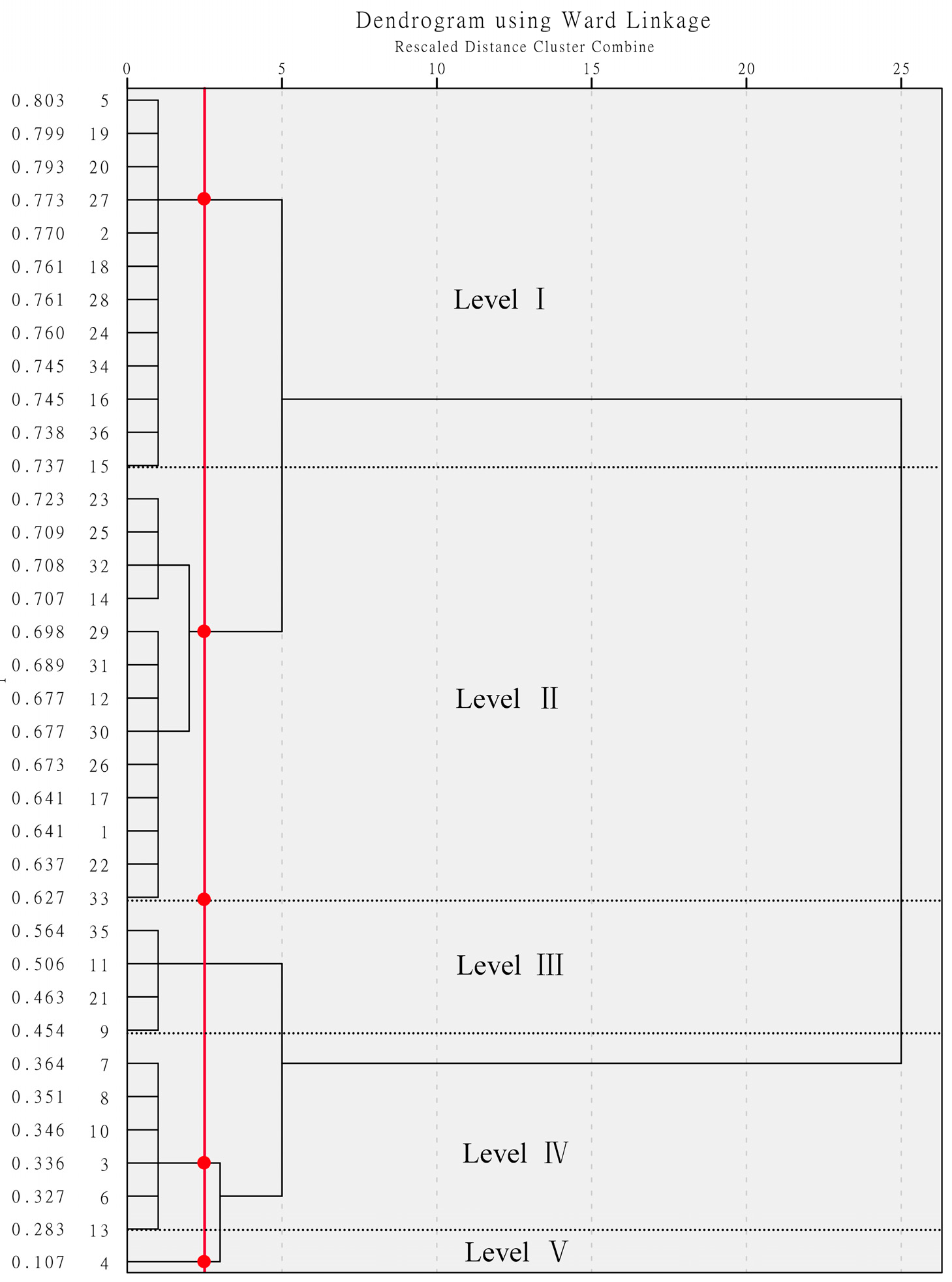
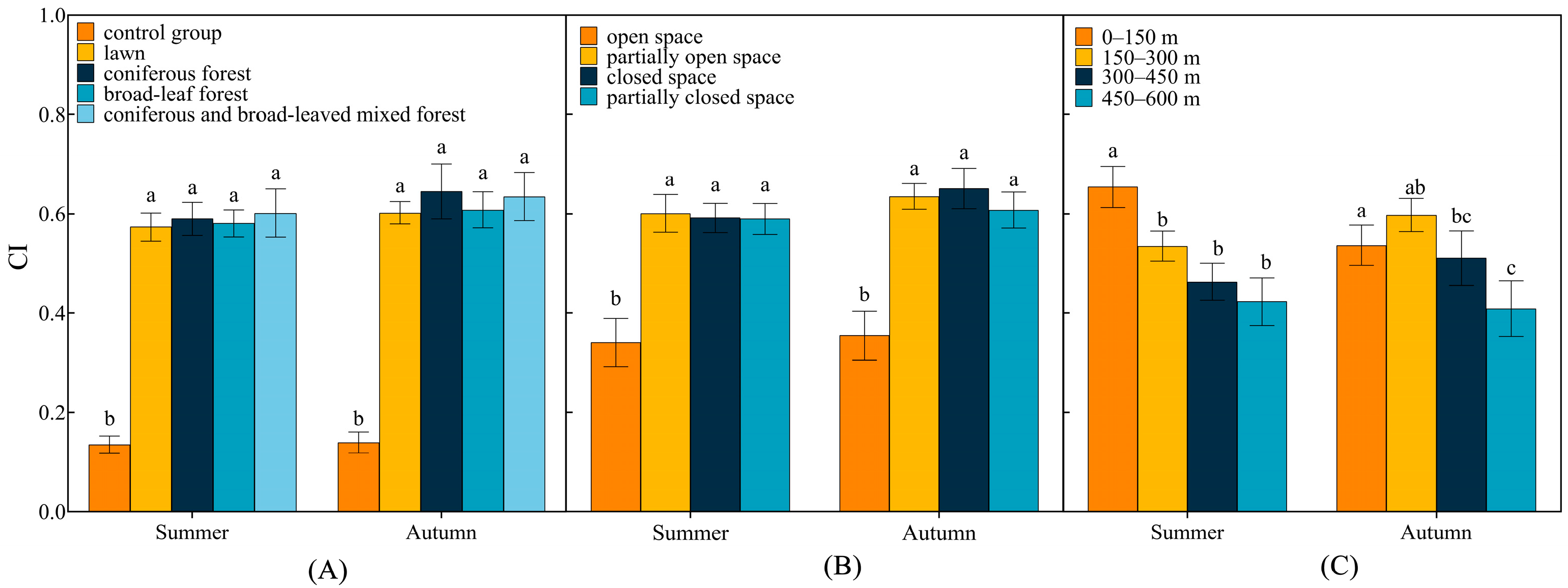

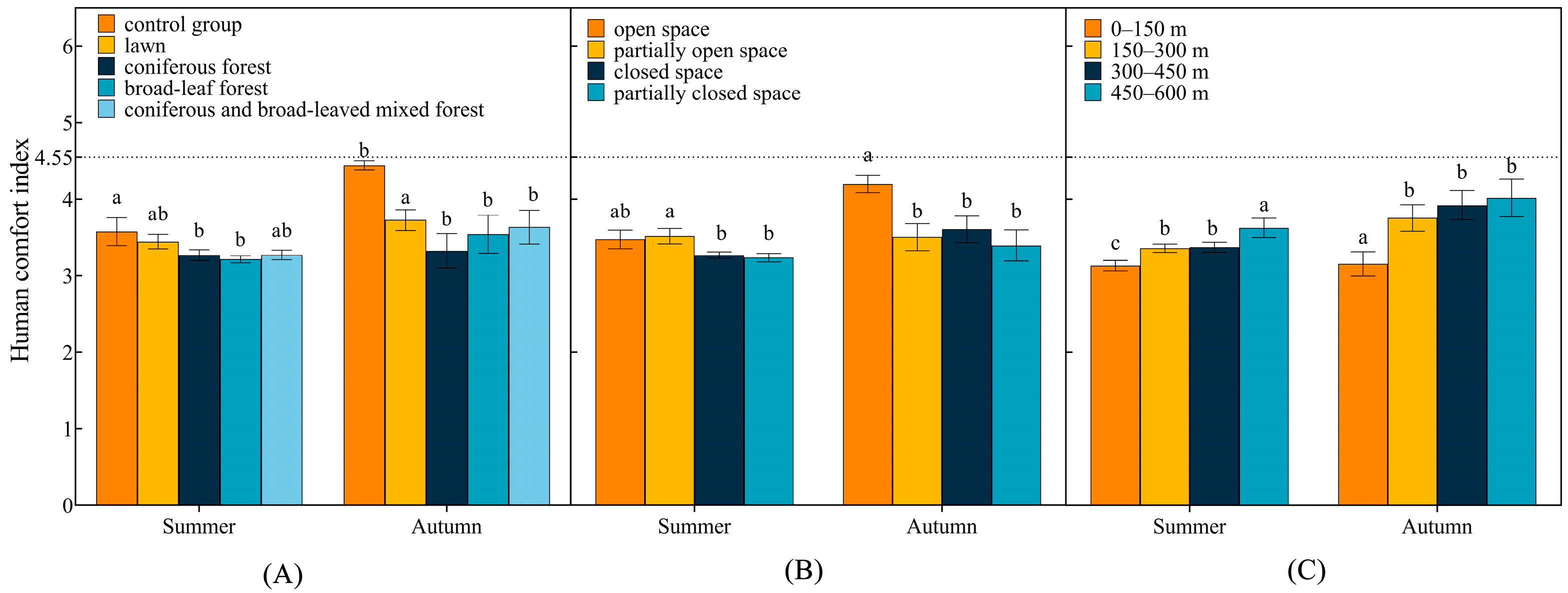
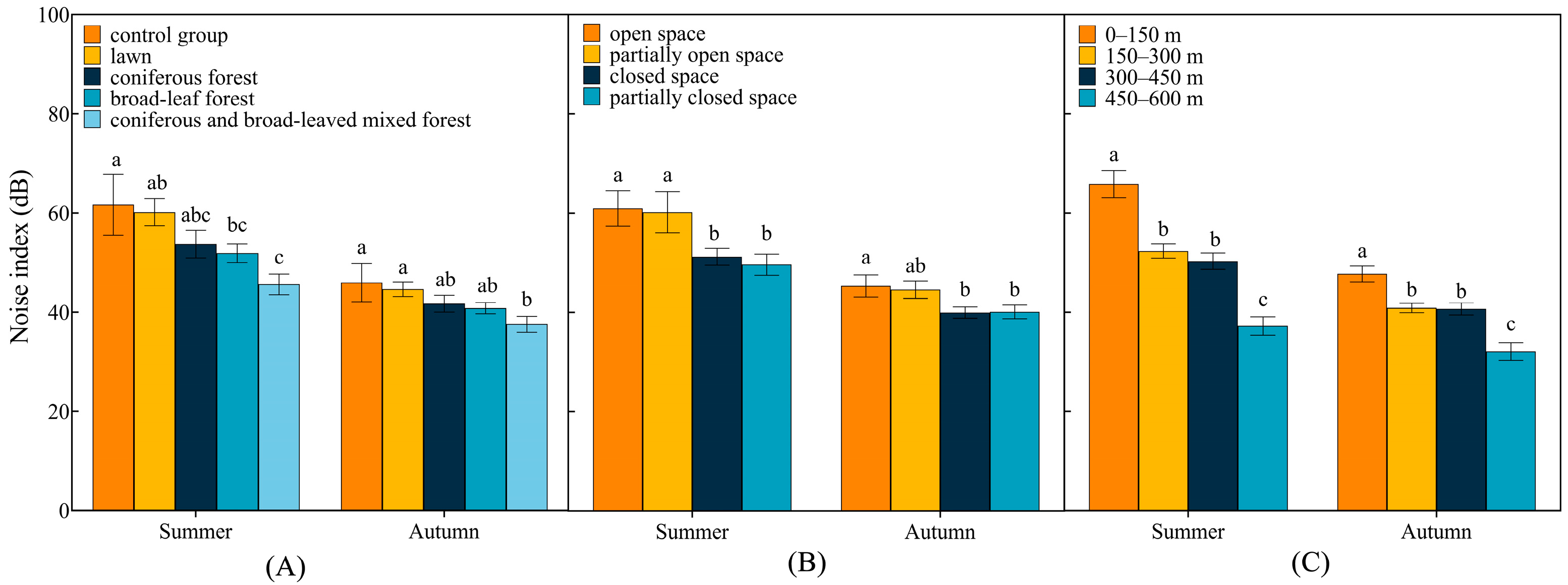

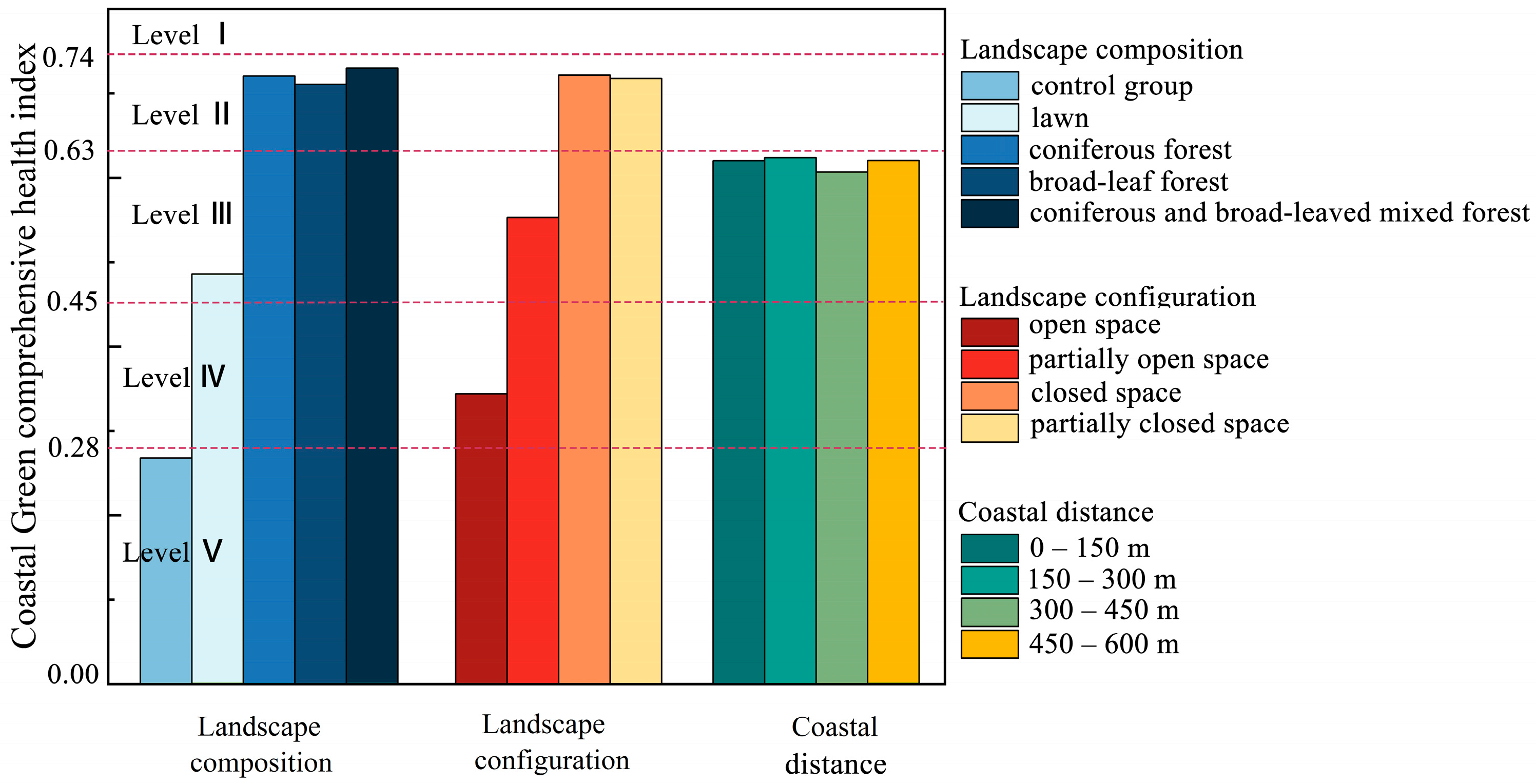
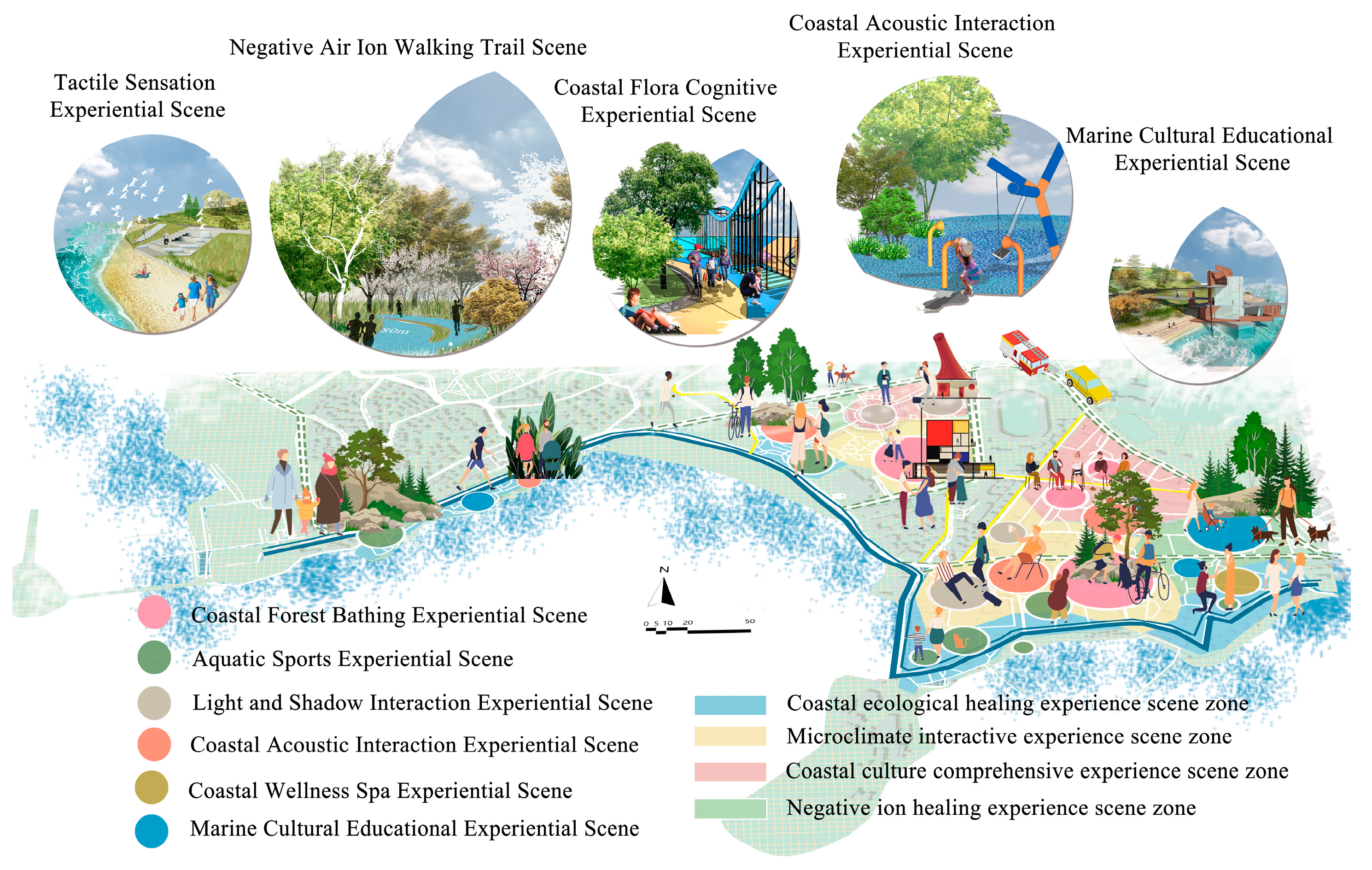
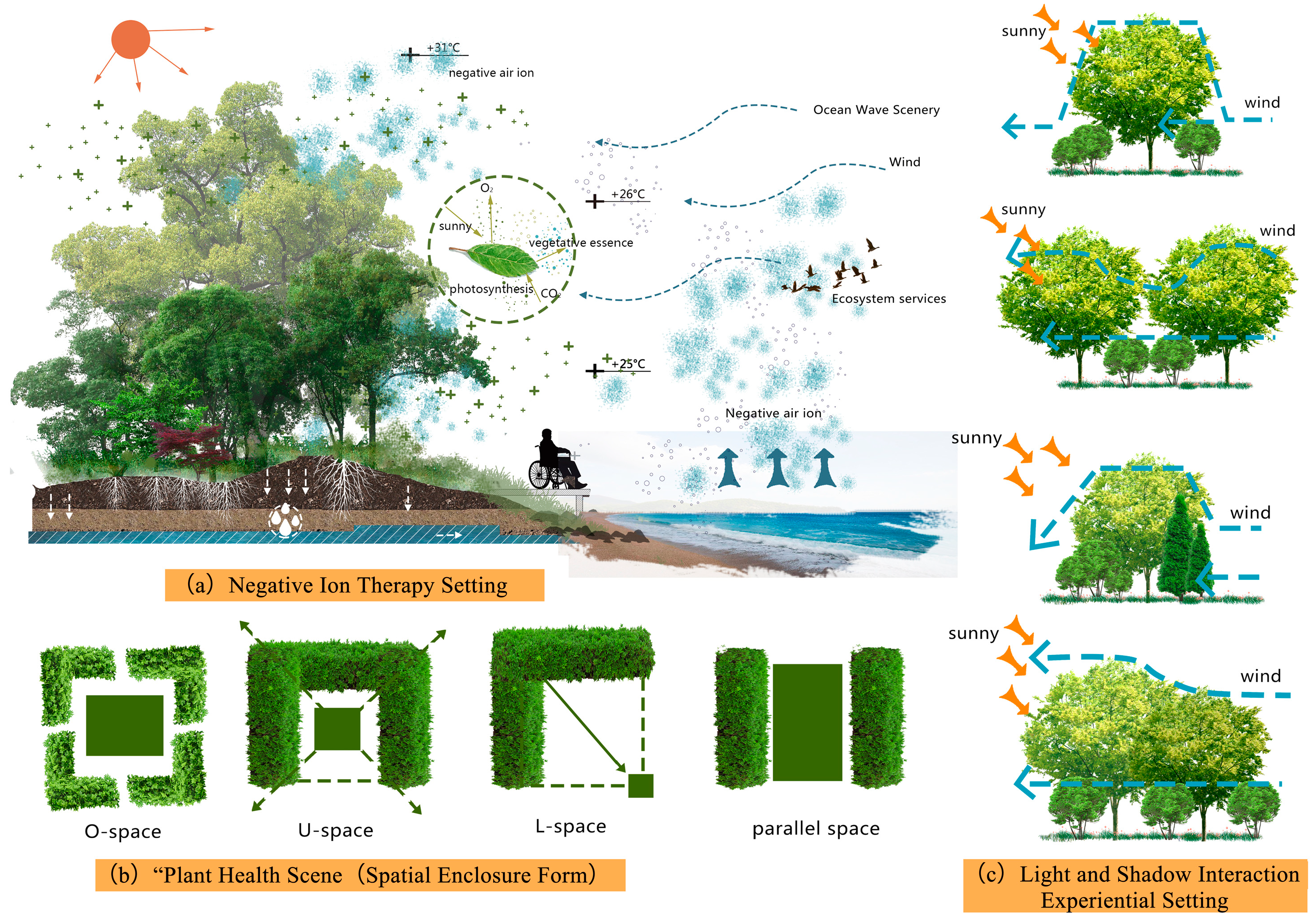
| Indicators | Principal Component | Component Matrix | Weight Value | ||
|---|---|---|---|---|---|
| 1 | 2 | 1 | 2 | ||
| PM10 | 0.566 | −0.038 | 0.944 | −0.042 | 0.25 |
| PM2.5 | 0.5324 | −0.145 | 0.888 | −0.161 | 0.21 |
| Negative air ion concentration/NAIC | 0.513 | 0.206 | 0.855 | 0.229 | 0.27 |
| Acoustic environments index/NF | 0.224 | 0.753 | 0.373 | 0.836 | 0.25 |
| Human comfort index/S | 0.289 | −0.607 | 0.483 | −0.673 | 0.01 |
| Eigenvalues | 2.782 | 1.231 | |||
| Variance contribution rate (%) | 55.634 | 24.621 | |||
| Cumulated contribution rate (%) | 55.634 | 80.256 | |||
| Grades | Index Range | Degree of Comprehensive Healthcare Benefits |
|---|---|---|
| I | CGHI > 0.74 | Very strong |
| II | 0.74 > CGHI ≥ 0.63 | Strong |
| III | 0.63 > CGHI ≥ 0.45 | Medium |
| IV | 0.45 > CGHI ≥ 0.28 | Weak |
| V | CGHI < 0.28 | Very weak |
Disclaimer/Publisher’s Note: The statements, opinions and data contained in all publications are solely those of the individual author(s) and contributor(s) and not of MDPI and/or the editor(s). MDPI and/or the editor(s) disclaim responsibility for any injury to people or property resulting from any ideas, methods, instructions or products referred to in the content. |
© 2023 by the authors. Licensee MDPI, Basel, Switzerland. This article is an open access article distributed under the terms and conditions of the Creative Commons Attribution (CC BY) license (https://creativecommons.org/licenses/by/4.0/).
Share and Cite
Leng, X.; Kong, D.; Gao, Z.; Wang, K.; Zhang, Y.; Li, C.; Liang, H. Study on the Comprehensive Health Effects of Coastal Green Areas in Qingdao City, China. Forests 2023, 14, 2463. https://doi.org/10.3390/f14122463
Leng X, Kong D, Gao Z, Wang K, Zhang Y, Li C, Liang H. Study on the Comprehensive Health Effects of Coastal Green Areas in Qingdao City, China. Forests. 2023; 14(12):2463. https://doi.org/10.3390/f14122463
Chicago/Turabian StyleLeng, Xiushan, Di Kong, Zhiwen Gao, Kai Wang, Yu Zhang, Chunyu Li, and Hong Liang. 2023. "Study on the Comprehensive Health Effects of Coastal Green Areas in Qingdao City, China" Forests 14, no. 12: 2463. https://doi.org/10.3390/f14122463
APA StyleLeng, X., Kong, D., Gao, Z., Wang, K., Zhang, Y., Li, C., & Liang, H. (2023). Study on the Comprehensive Health Effects of Coastal Green Areas in Qingdao City, China. Forests, 14(12), 2463. https://doi.org/10.3390/f14122463








